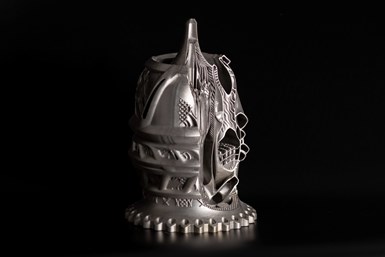EOS, Hyperganic Partnership to Elevate Space Components
Integration of Hyperganic Core, an AI-powered engineering software platform, with EOS’ digital additive manufacturing solutions aims to advance the space propulsion field.
EOS is entering a partnership with Hyperganic, a global technology software company, to advance the field of space propulsion.
For centuries, humans used drawing boards to translate ideas onto paper before CAD systems changed the game. Yet, even small design changes can still require laborious remodeling work. Because every iteration costs time and money, CAD-based approaches compel engineers to design conservatively instead of pushing the limits, the companies say.
At the same time, freedom of design is one of additive manufacturing’s (AM) guiding principles, enabling part structures and applications that were impossible to manufacture using traditional production processes. The partnership between EOS and Hyperganic now takes this approach to the next level.
“We are now partnering with Hyperganic to introduce another paradigm shift in AM. It is a design shift that expands solution spaces as well as performance levels,” says Dr. Hans J. Langer, EOS founder and an AM creative. “At the same time, it will revolutionize the design process for AM, making AM a truly digital workflow from software-generated algorithmic engineering to digital manufacturing.”
The company says a radical example is the aerospike rocket engine designed by Hyperganic and manufactured by EOS and AMCM (an EOS Group company). The aerospike engine, classically considered a tremendous engineering and manufacturing challenge, was built from the ground up using an algorithmic model by Hyperganic. One of the hundreds of designs produced by Hyperganic in just days was printed on the EOS M 400-4. The complex part was printed with no supports using the EOS NickelAlloy IN718 process.
Consequently, the aerospike engine was automatically reengineered for production on a substantially larger AMCM M 4K from AMCM in EOS CopperAlloy CuCrZr. The combination of this design complexity with the capability to print in this size in a reliable manner is intended to drive the next innovations in space propulsion.
Related Content
-
Video: 5" Diameter Navy Artillery Rounds Made Through Robot Directed Energy Deposition (DED) Instead of Forging
Big Metal Additive conceives additive manufacturing production factory making hundreds of Navy projectile housings per day.
-
3D Printed Titanium Replaces Aluminum for Unmanned Aircraft Wing Splice: The Cool Parts Show #72
Rapid Plasma Deposition produces the near-net-shape preform for a newly designed wing splice for remotely piloted aircraft from General Atomics. The Cool Parts Show visits Norsk Titanium, where this part is made.
-
At General Atomics, Do Unmanned Aerial Systems Reveal the Future of Aircraft Manufacturing?
The maker of the Predator and SkyGuardian remote aircraft can implement additive manufacturing more rapidly and widely than the makers of other types of planes. The role of 3D printing in current and future UAS components hints at how far AM can go to save cost and time in aircraft production and design.















